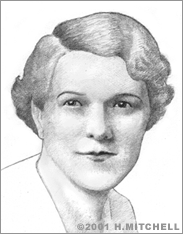Mary Jacob
After decades of stuffing themselves into seemingly barbaric undergarments, mostly of a corset-like nature, women around the world finally began to get fed up. In 1913, a New York socialite decided to do something about it. The first modern brassiere was created by Mary Phelps Jacob. She patented her design, and now the brassiere is a standard part of nearly every modern woman’s wardrobe.
Jacob came up with the idea for her brassiere after she bought an evening gown for an event that she was planning to attend. At the time, women wore corsets stiffened with whaleback bones and steel rods. She tried on the dress with one of these corsets, however, and found that the whalebones poked out visibly around the plunging neckline and under the sheer fabric.
Jacob had a better idea. She took two silk handkerchiefs and some pink ribbon and, with the help of her maid, fashioned herself the very first bra. Family and friends almost immediately asked Jacob to create brassieres for them, too. One day, she received a request for one of her contraptions from a stranger, who offered a dollar for her efforts. She knew then that this could become a viable business. On November 3, 1914, she was awarded a patent for the "Backless Brassiere". The undergarment name "brassiere" was derived from the old french word for "upper arm."
Then, Jacob set up a business, using the name Caresse Crosby instead of her own. Later, she sold the brassiere patent to the Warner Brothers Corset Company in Bridgeport, Connecticut for $1,500. The Warner Brothers Corset Company made $15 million dollars from the bra over the next 30 years.
It is important to note that Jacob did not invent the first bra ever. Her design was simply the first one to be widely used. It appears that a woman named Marie Tucek patented the first brassiere in 1893. Her device included separate pockets for the breasts and straps that went over the shoulder, which were fastened by hook-and-eye closures. Jacob's patent was for a device that was lightweight and flattened the breasts, but her bra did not have cups to support the breasts. Many innovations were made to the brassiere throughout the years, including the use of elastic and standard cup sizes. In 1928, a Russian immigrant named Ida Rosenthal founded Maidenform. Rosenthal was responsible for grouping women into bust size categories (cup sizes).
It has been said that the bra, as it came to be called in the 1930s, owed its success to World War I. The war shook up gender roles, putting many women to work in factories and uniforms for the first time. Then, in 1917, the U.S. War Industries Board asked women to stop buying corsets in order to reserve metal. They did stop buying corsets, which freed up some 28,000 tons of metal – enough to build two battleships.
Jacob died in 1970, but she lived long enough to see the bra go through a number of transformations and become immensely popular all over the world. She was also politically active and founded the organization Women Against War.


